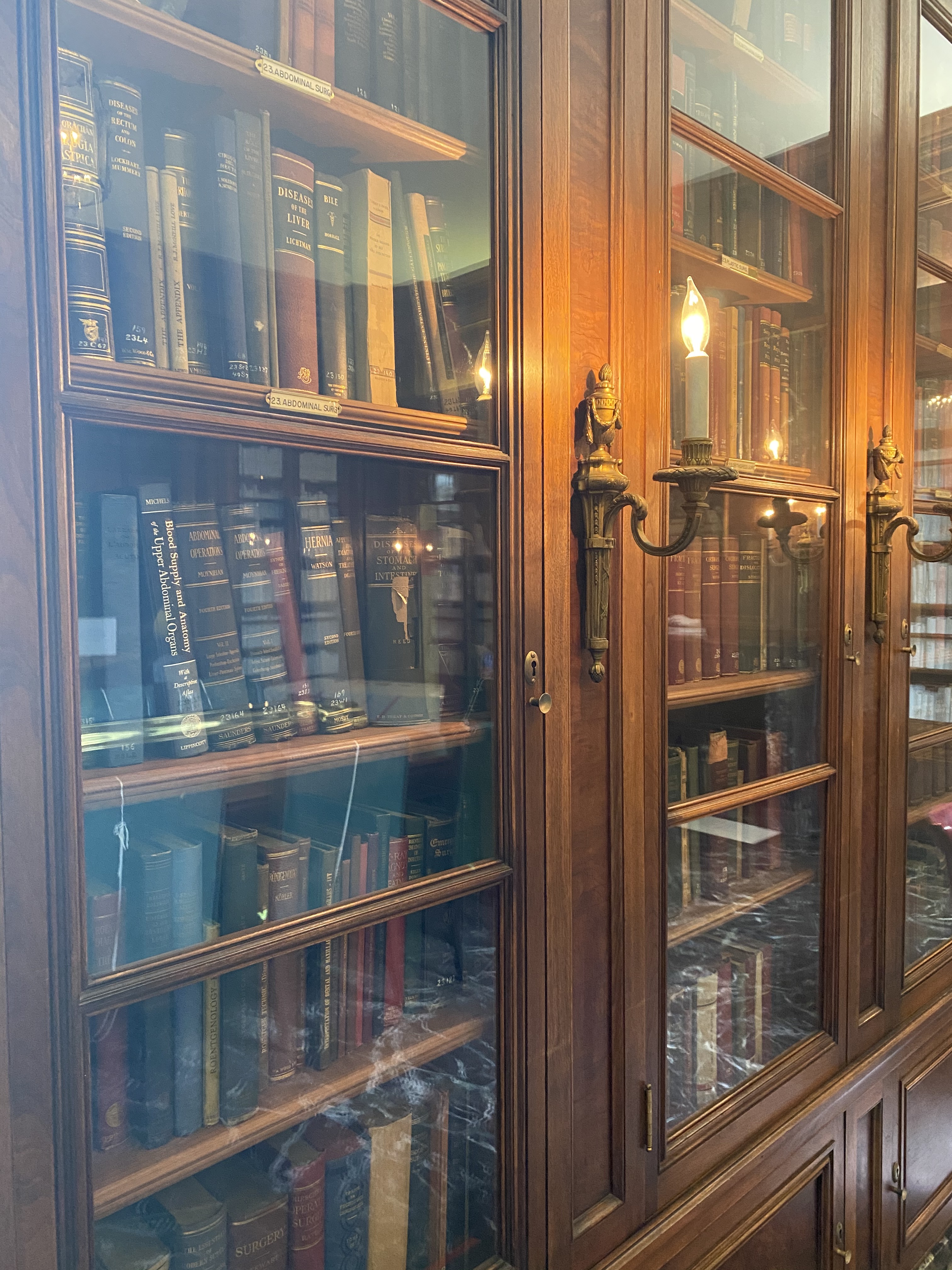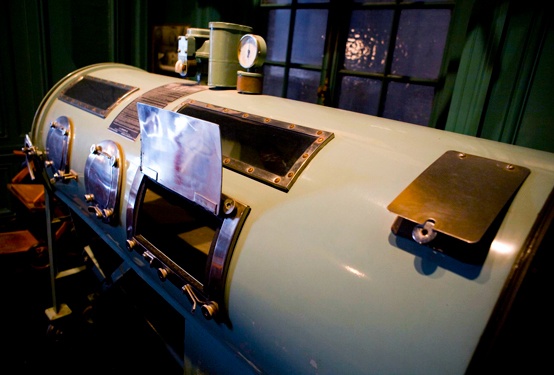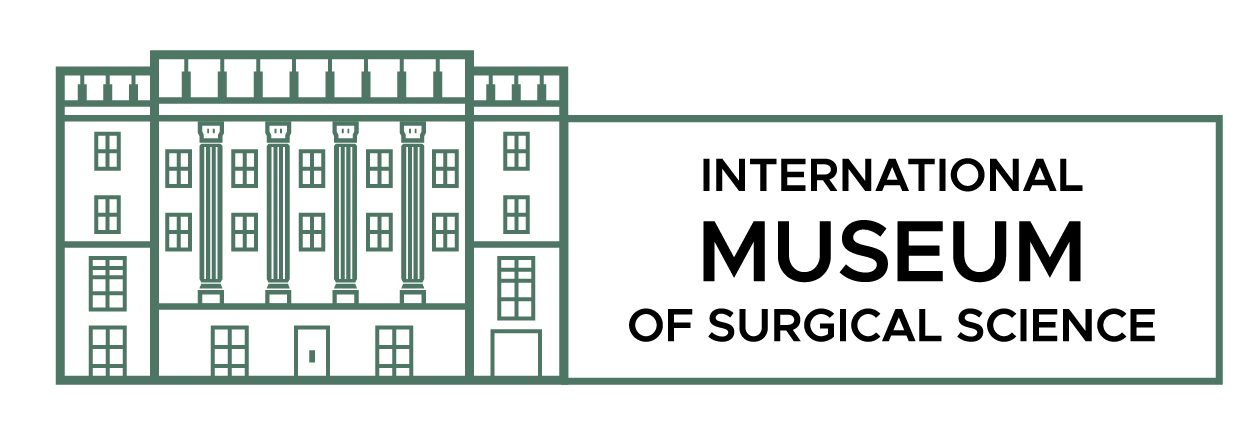Published by Kelly Christian
I’ve been working as the Library Collections Intern here at the International Museum of Surgical Science since the beginning of February. I was very excited to have this opportunity to better acquaint myself with the library collection, understand the specific needs of historic books, and work on honing my skills in cataloging. I’m currently a remote student studying library science at the University of Wisconsin – Milwaukee, and am concentrating in archives. While my time here was planned to go through June, the pandemic required an interruption to my time in this role, which is now coming to an end mid-August. That said, I’ve found that being in and around the Museum has provided me with a unique perspective on reflecting on the pandemic, if not a bit of comfort in understanding the scope of written medical research available in the books that I catalog.

Max Thorek Manuscripts and Rare Books Collection, 2nd Floor, International Museum of Surgical Science.
Much of my role has consisted of cataloging about 300 books, which includes reviewing, updating, and creating metadata records for each item. Metadata is “data about data”, and is composed of all of the “stuff” that makes books searchable. This includes everything from titles, authors, and subject headings, to publication year and provenance. For each entry, I’d review the specific details about the book, look for typos or inaccurate information in the database, and check each book for any preservation concerns such as mold and mildew, red rot (leather decay in a book’s cover or spine), or even pests. Most books in the collection are currently wrapped individually in acid-free paper in order to keep any issues the book may have inside the wrapping, while also safeguarding the book against any external threats such as sunlight. By completing these steps for each book, I’m able to spend some time with each item as I process and review it.
As I skim through each book, I take the longest pauses to review books with illustration. I have a background in visual studies and absolutely love historic photography and illustration. The inception of photography in 1839 eventually led to a widespread introduction of photographs to printed materials by 1845. Photographs really changed everything, and gave visual evidence to medical techniques and research. Doctors were able to photograph patients and demonstrate procedures, and then publish the results. These accurate images could depict someone at the initial stages of disease, document the surgical intervention, and then capture the healed patient. It must have been incredible to see this in a book for the first time. Before photography, many books relied on illustrations, which may have lacked detail or accuracy. I was especially moved as I cataloged “Tumors of the Jaws” from 1912, which included 353 photographs. It documented the medical procedures performed by the doctor, but ultimately, I saw the resiliency of patients who were impacted by cancerous growths that caused facial deformities. There was finally evidence to demonstrate that change was possible.

Scudder, Charles Locke. Tumors of the Jaws. United Kingdom: W. B. Saunders, 1912.
Viewing these books has also allowed me to see how medicine has evolved and progressed through time, which is exceptionally important right now as we live through a pandemic. We are in a moment which is heavily impacted by how medical research is conducted and disseminated to the public. It is at this very moment that many of these historic books also engage in: publishing findings, re-evaluating prior claims, and making updates to the body of medical knowledge that is shared with the world. While medical advancement has been foundational in making positive changes in public health, medical advancement is not static, but rather evolves with technology, research, and implementation. Ultimately, what may have been fact over a century ago, may have been debunked with new medical research.
The coronavirus pandemic has only demonstrated what the library also shows: humans must be dynamic in their response to new medical knowledge. As we’ve learned more and more about how the coronavirus is transmitted, we’ve had to reconsider how we live our lives. While masks were not first encouraged in the United States in the spring of 2020, the summer of 2020 requires them. These shifts in behavior and understanding of disease exemplify the evolution of medicine, which is not perfect, nor is it as fast as we’d like it to be. History, however, teaches us that in order to evolve more fully as a society, we must be cognizant of our past mistakes in order to best prepare for our future. The historic books held by the IMSS are a creative interpretation of just that. By reading and reviewing materials from this library, we’re able to see how far humans have progressed in the medical field, even with many missteps along the way.
There are many outdated ideas about disease that are no longer relevant. The medical theory of miasma once stated that many transmittable diseases such as cholera or even chlamydia, were spread by unhealthy air quality, often connected to a bad smell. Medical research, and more importantly germ theory, were able to render the miasma theory of disease to be obsolete. While ideas about miasma were part of medicine for centuries, its popularity peaked in the beginning of the 19th century. Germ theory, which is still understood today as the leading approach to disease, suggested that disease was spread by pathogens that were too small to be seen by the naked eye. This is not to say that air quality isn’t a valid health concern, but rather that the scientific understanding of air quality drastically changed with the advent of germ theory.
The switch from miasma, which had been embedded in cultural norms for years, to germ theory, certainly took time. For example, the concept of breathing the air at night was deemed to be less healthy than breathing the air in the day. The anxiety of being outside at night was heavy with concern about contracting a disease. Medical advancement eventually proved that this night air was not fundamentally different from the air of the daytime, and being outside at night suddenly had less stigma. It is that adjustment period that reminds me that we as a society in this cultural moment are also in flux as we learn a way to understand how our bodies respond to this new disease, and how it gets from one person to the next. Even our recent history in understanding pandemics informs how we move through the world.

Emerson Respirator (Iron Lung), c. 1930, Mfr. J.H. Emerson Co., Cambridge, MA, Gift of the University of Chicago, 1977.
The library is a delight to visit, and is housed next to the IMSS display of the iron lung. Since the museum has re-opened, I’ve watched our patrons look at the iron lung with their masks on before they came to look at the books tidied and wrapped in the library shelves. I’m humbled to remember that the iron lung was designed to manage the terrifying effects of the polio pandemic, which does bear some resemblance to Covid-19. While much of my time has been spent with the books of the collection, it connects me to the larger trajectory of how medical research has impacted our daily lives, how it shapes how we understand our world, and how the resiliency of the human experience allows us to adjust as we learn about disease. The IMSS is a space in which patrons can consider the complicated yet necessary concept of medical progress and its tangible effect on human life, which is more important than ever as we adjust to live through this contemporary pandemic.
References:
- Scudder, Charles Locke. Tumors of the Jaws. United Kingdom: W. B. Saunders, 1912.
Kelly Christian is the current Library Collection Intern at the International Museum of Surgical Science. She is in her second semester of graduate school at the University of Wisconsin – Milwaukee where she is pursuing her Master of Library & Information Science (MLIS), with a concentration in Archives. Kelly enjoys learning about how death and medicine have driven cultural change across American history.


